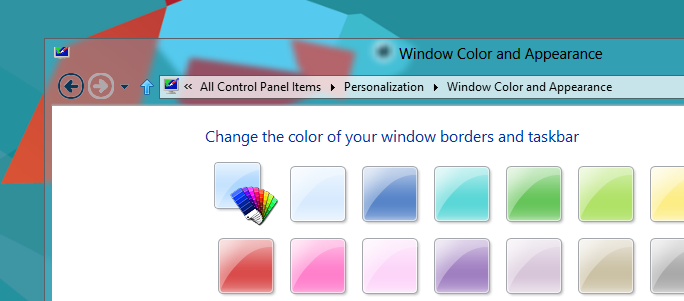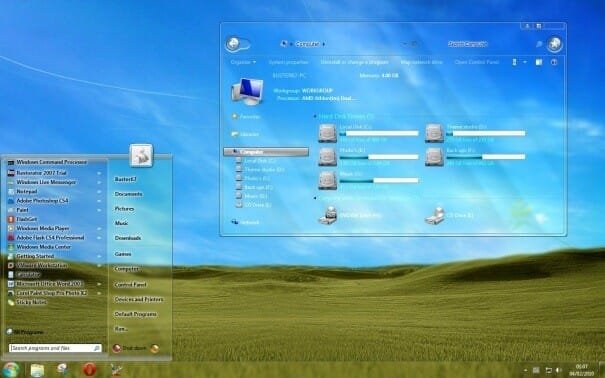

- #AERO THEME ENABLE ON VIRTUALMACHINE INSTALL#
- #AERO THEME ENABLE ON VIRTUALMACHINE DRIVERS#
- #AERO THEME ENABLE ON VIRTUALMACHINE DRIVER#
- #AERO THEME ENABLE ON VIRTUALMACHINE FULL#
- #AERO THEME ENABLE ON VIRTUALMACHINE WINDOWS 7#
#AERO THEME ENABLE ON VIRTUALMACHINE DRIVER#
After the driver installs, reboot the computer.
#AERO THEME ENABLE ON VIRTUALMACHINE DRIVERS#
You will receive an error about the drivers not being signed.
#AERO THEME ENABLE ON VIRTUALMACHINE INSTALL#
When you have to install the driver, mount the ISO you downloaded way back in the beginning and point it to the 'video_xpdm'Ħ. 5048 & 5219 use the XP-style interface while the later builds use the Vista-style.)ĥ. (Sorry, but there is no screenshot for this one as these builds use different interfaces. Select the options required to choose your driver manually. Select 'Update Driver Software' on the menu that comes up.Ĥ. After this, open Device Manager, browse to the 'Display Adapters' section, and right-click on the name of your display adapter.

Over there, create a DWORD key named UseMachineCheck and set its value to 0.ģ. Over there, create a DWORD key named EnableMachineCheck and set its value to 0.īrowse to HKEY_CURRENT_USER\Software\Microsoft\DWM. From here, it branches off into two different paths, depending on which build you want to use:īrowse to HKEY_LOCAL_MACHINE\Software\Microsoft\DWM. NOTE: For 5231.X, use 'Workstation 6.0' as the compatibility mode!Ģ. It will be a bit slow, but it works.īuilds 5048, 5219-5270: (Thanks to fred30w and ovctvct!)ġ. Aero Glass should be automatically enabled. After the display driver installs, reboot the VM.ġ0. Point the installer to the 'video_wddm' folder of the root of the ISO and click 'Next'. Select 'Browse my computer for driver software' and mount the ISO containing the display drivers from the 'Items you need' section.ĩ. Select 'Update Driver Software' on the menu that comes up.Ĩ. Open Device Manager, browse to the 'Display Adapters' section, and right-click on the name of your display adapter. Over there, create a DWORD key named CompositionPolicy and set its value to 2.ħ. After installing, open regedit and browse to Computer\HKEY_CURRENT_USER\Software\Microsoft\Windows\DWM.Ħ. Install the build as normal, including setting the BIOS Date.ĥ.

Set the Guest OS option to 'Windows Vista'.Ĥ. You do not need to change the compatibility in earlier versions.ģ. Set the HW compatibility to Workstation 10.0 (for 11 users). First, start creating your VM, but make sure to select Custom in the first screen.Ģ. If you are using an AMD64 (圆4) build, you can get the 圆4 drivers here:ģ. You can get an ISO that has them here: !CMQzyDTJ!rQ72sAqgHi5Q. The WDDM Display Drivers from Workstation 11. A relatively recent version of VMware Workstation. This tutorial was tested with the following builds: (Professional/Ultimate unless otherwise noted)ĥ270 (Ultimate & Enterprise Server) (Ultimate also by ovctvct)ĥ456 (Home Premium & Ultimate) (Ultimate also by ovctvct)ĥ472 (Ultimate & Home Premium) (Ultimate also by fred30w)ĥ536 (Business & Ultimate) (Ultimate also by ovctvct)ĥ600 (Datacenter Server & Ultimate) (Ultimate by ovctvct and Arths)ġ. Similar techniques but more steps are required for Windows 2008 Server flavors of Windows, where not even sound support is turn on by default.This is a small tutorial for enabling Aero Glass in most post-reset Vista Builds, namely the builds from the 50xx range onwards. If not, click the remote system's start orb, type Personalization, and select an Aero Theme. Now click on Connect, and you should see Aero active on the remote system (translucent effects).From your client workstation, run Remote Desktop Connection ( mstsc.exe) and choose Options, Display, be sure High Quality (32 bit) color is chosen,Īnd on the Experience tab, be sure Desktop composition checkbox is on.
#AERO THEME ENABLE ON VIRTUALMACHINE WINDOWS 7#
In vSphere Client, choose the Windows 7 virtual machine, then Edit virtual machine settings, choose Hardware tab, Video card, turn on Auto-detect settings and turn on Enable 3D support.So, enough of that downer stuff, still ready to give it a try?
#AERO THEME ENABLE ON VIRTUALMACHINE FULL#
You'll also find that Windows+Tab effects only work with full screen Remote Desktop Sessions, but all the other effects run fine even in Windowed mode, as seen in screenshot below.I tested with vZilla, a Core i7 based system with no discreet GPU added, you may have considerably less luck with older hardware.You'll really only want this for VMs where you really want improved graphical performance/acceleration.You'll need to have a fast (LAN) connection, of course.You'll need to have VMware Tools installed.Here's the possible gotchas to ignore (everybody else does!): Just follow these steps, and you'll be able to use Remote Desktop Connection to see the Aero interface in your VMs, using either the vSphere Client Console, or using the much more practical, Remote Desktop Connection. No need for a GPU on your ESXi 5.0 or later system: Aero can work on VMs without any physical GPU on the host.


 0 kommentar(er)
0 kommentar(er)
